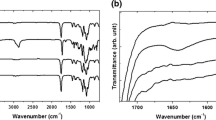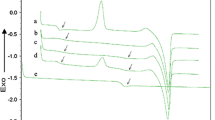Abstract
A number of poly(lactic acid-co-glycolic acid)/polyurethane (PLGA/PU) blend films with various PU mole contents were prepared by casting the polymer blend solution in chloroform. The surface morphologies of the PLGA/PU blend films were studied by scanning electron microscopy (SEM). The thermal, mechanical and chemical properties of the PLGA/PU blend films were investigated by differential scanning calorimetry (DSC), thermogravimetric analysis (TGA), tensile tests and surface contact angle tests. The results revealed that the introduction of PU could markedly modify the properties of PLGA films.
Similar content being viewed by others
References
Anderson, J. M., & Miller, K. M. (1984). Biomaterial biocompatibility and the macrophage. Biomaterials, 5, 5–10. DOI: 10.1016/0142-9612(84)90060-7.
Angelova, N., & Hunkeler, D. (1999). Rationalizing the design of polymeric biomaterials. Trends in Biotechnology, 17, 409–421. DOI: 10.1016/s0167-7799(99)01356-6.
Bai, L. Q., Zhu, L. J., Min, S. J., Liu, L., Cai, Y. R., & Yao, J. M. (2008). Surface modification and properties of Bombyx mori silk fibroin films by antimicrobial peptide. Applied Surface Science, 254, 2988–2995. DOI: 10.1016/j.apsusc.2007.10.049.
Bittner, B., Witt, C., Mäder, K., & Kissel, T. (1999). Degradation and protein release properties of microspheres prepared from biodegradable poly(lactide-co-glycolide) and ABA triblock copolymers: influence of buffer media on polymer erosion and bovine serum albumin release. Journal of Controlled Release, 60, 297–309. DOI: 10.1016/s0168-3659(99)00085-1.
Blanco-Príeto, M. J., Besseghir, K., Zerbe, O., Andris, D., Orsolini, P., Heimgartner, F., Merkle, H. P., & Gander, B. (2000). In vitro and in vivo evaluation of a somatostatin analogue released from PLGA microspheres. Journal of Controlled Release, 67, 19–28. DOI: 10.1016/s0168-3659(99)00289-8.
Cleland, J. L., Johnson, O. L., Putney, S., & Jones, A. J. S. (1997). Recombinant human growth hormone poly(lactic-co-glycolic acid) microsphere formulation development. Advanced Drug Delivery Reviews, 28, 71–84. DOI: 10.1016/s0169-409x(97)00051-3.
Elbert, D. L., & Hubbell, J. A. (1998). Self-assembly and steric stabilization at heterogeneous, biological surfaces using adsorbing block copolymers. Chemistry and Biology, 5, 177–183. DOI: 10.1016/s1074-5521(98)90062-x.
Ganji, F., & Abdekhodaie, M. J. (2010). Chitosan-g-PLGA copolymer as a thermosensitive membrane. Carbohydrate Polymers, 80, 740–746. DOI: 10.1016/j.carbpol.2009.12.021.
Göpferich, A., Peter, S. J., Lucke, A., Lu, L., & Mikos, A. G. (1999). Modulation of marrow stromal cell function using poly(d,l-lactic acid)-block-poly(ethylene glycol)-monomethyl ether surfaces. Journal of Biomedical Materials Research Part A, 46, 390–398. DOI: 10.1002/(SICI)1097-4636(19990905)46:3〈390::AID-JBM12〉3.0.CO;2-N.
Harjunalanen, T., & Lahtinen, M. (2003). The effects of altered reaction conditions on the properties of anionic poly(urethane-urea) dispersions and films cast from the dispersions. European Polymer Journal, 39, 817–824. DOI: 10.1016/s0014-3057(02)00279-3.
Holzer, M., Vogel, V., Mäntele, W., Schwartz, D., Haase, W., & Langer, K. (2009). Physico-chemical characterisation of PLGA nanoparticles after freeze-drying and storage. European Journal of Pharmaceutics and Biopharmaceutics, 72, 428–437. DOI: 10.1016/j.ejpb.2009.02.002.
Houchin, M. L., Neuenswander, S. A., & Topp, E. M. (2007). Effect of excipients on PLGA film degradation and the stability of an incorporated peptide. Journal of Controlled Release, 117, 413–420. DOI: 10.1016/j.jconrel.2006.11.023.
Ignatius, A. A., & Claes, L. E. (1996). In vitro biocompatibility of bioresorbable polymers: poly(l, dl-lactide) and poly(l-lactide-co-glycolide). Biomaterials, 17, 831–839. DOI: 10.1016/0142-9612(96)81421-9.
Jain, R. A. (2000). The manufacturing techniques of various drug loaded biodegradable poly(lactide-co-glycolide) (PLGA) devices. Biomaterials, 21, 2475–2490. DOI: 10.1016/s0142-9612(00)00115-0.
Jeong, J. H., Lim, D. W., Han, D. K., & Park, T. G. (2000). Synthesis, characterization and protein adsorption behaviors of PLGA/PEG di-block co-polymer blend films. Colloids and Surfaces B: Biointerfaces, 18, 371–379. DOI: 10.1016/s0927-7765(99)00162-9.
Kondo, T., Sawatari, C., Manley, R. S. J., & Gray, D. G. (1994). Characterization of hydrogen bonding in cellulose-synthetic polymer blend systems with regioselectively sub stituted methylcellulose. Macromolecules, 27, 210–215. DOI: 10.1021/ma00079a031.
Langer, R. (1995). 1994 Whitaker lecture: Polymers for drug delivery and tissue engineering. Annals of Biomedical Engineering, 23, 101–111. DOI: 10.1007/bf02368317.
Lio, K., Minoura, N., & Nagura, M. (1995). Swelling characteristics of a blend hydrogel made of poly(allylbiguanido-co-allylamine) and poly(vinyl alcohol). Polymer, 36, 2579–2583. DOI: 10.1016/0032-3861(95)91204-k.
Loo, S. C. J., Ooi, C. P., & Boey, Y. C. F. (2004). Radiation effects on poly(lactide-co-glycolide) (PLGA) and poly(l-lactide) (PLLA). Polymer Degradation and Stability, 83, 259–265. DOI: 10.1016/s0141-3910(03)00271-4.
Loo, S. C. J., Ooi, C. P., Wee, S. H. E., & Boey, Y. C. F. (2005). Effect of isothermal annealing on the hydrolytic degradation rate of poly(lactide-co-glycolide) (PLGA). Biomaterials, 26, 2827–2833. DOI: 10.1016/j.biomaterials.2004.08.031.
Murakami, H., Kobayashi, M., Takeuchi, H., & Kawashima, Y. (2000). Utilization of poly(dl-lactide-co-glycolide) nanoparticles for preparation of mini-depot tablets by direct compression. Journal of Controlled Release, 67, 29–36. DOI: 10.1016/s0168-3659(99)00288-6.
Nishio, Y., & Manley, R. S. J. (1988). Cellulose-poly(vinyl alcohol) blends prepared from solutions in N,N-dimethylacetamide-lithium chloride. Macromolecules, 21, 1270–1277. DOI: 10.1021/ma00183a016.
Park, J. S., Park, J. W., & Ruckenstein, E. (2001). Thermal and dynamic mechanical analysis of PVA/MC blend hydogels. Polymer, 42, 4271–4280. DOI: 10.1016/s0032-3861(00)00768-0.
Park, B. J., Seo, H. J., Kim, J., Kim, H. L., Kim, J. K., Choi, J. B., Han, I., Hyun, S. O., Chung, K. H., & Park, J. C. (2010). Cellular responses of vascular endothelial cells on surface modified polyurethane films grafted electospun PLGA fiber with microwave-induced plasma at atmospheric pressure. Surface & Coatings Technology, 205, s222–s226. DOI: 10.1016/j.surfcoat.2010.07.087.
Peppas, N. A., Huang, Y., Torres-Lugo, M., Ward, J. H., & Zhang, J. (2000). Physicochemical foundations and structural design of hydrogels in medicine and biology. Annual Review of Biomedical Engineering, 2, 9–29. DOI: 10.1146/annurev.bioeng.2.1.9.
Rowlands, A. S., Lim, S. A., Martin, D., & Cooper-White, J. J. (2007). Polyurethane/poly(lactic-co-glycolic) acid composite scaffolds fabricated by thermally induced phase separation. Biomaterials, 28, 2109–2121. DOI: 10.1016/j.biomaterials.2006.12.032.
Sawatari, C., & Kondo, T. (1999). Interchain hydrogen bonds in blend films of poly(vinyl alcohol) and its derivatives with poly(ethylene oxide). Macromolecules, 32, 1949–1955. DOI: 10.1021/ma980900o.
Schliecker, G., Schmidt, C., Fuchs, S., Wombacher, R., & Kissel, T. (2003). Hydrolytic degradation of poly(lactide-co-glycolide) films: effect of oligomers on degradation rate and crystallinity. International Journal of Pharmaceutics, 266, 39–49. DOI: 10.1016/s0378-5173(03)00379-x.
Steele, T. W. J., Huang, C. L., Widjaja, E., Boey, F. Y. C., Loo, J. S. C., & Venkatraman, S. S. (2011). The effect of polyethylene glycol structure on paclitaxel drug release and mechanical properties of PLGA thin films. Acta Biomaterialia, 7, 1973–1983. DOI: 10.1016/j.actbio.2011.02.002.
Stolnik, S., Dunn, S. E., Garnett, M. C., Davies, M. C., Coombes, A. G. A., Taylor, D. C., Irving, M. P., Purkiss, S. C., Tadros, T. F., Davis, S. S., & Illum, L. (1994). Surface modification of poly (lactide-co-glycolide) nanospheres by biodegradable poly(lactide)-poly(ethylene glycol) copolymers. Pharmaceutical Research, 11, 1800–1808. DOI: 10.1023 /a:1018931820564.
Sung, C. S. P., Smith, T. W., & Sung, N. H. (1980). Properties of segmented polyether poly(urethaneureas) based of 2,4-toluene diisocyanate. 2. Infrared and mechanical studies. Macromolecules, 13, 117–121. DOI: 10.1021/ma60073a023.
Tanaka, H., Suzuki, Y., & Yoshino, F. (1999). Synthesis and coating application of waterborne fluoroacrylic-polyurethane composite dispersions. Colloids and Surfaces A: Physicochemical and Engineering Aspects, 153, 597–601. DOI: 10.1016/s0927-7757(98)00482-8.
Thanki, P. N., Dellacherie, E., & Six, J. L. (2006). Surface characteristics of PLA and PLGA films. Applied Surface Science, 253, 2758–2764. DOI: 10.1016/j.apsusc.2006.05.047.
Vey, E., Roger, C., Meehan, L., Booth, J., Claybourn, M., Miller, A. F., & Saiani, A. (2008). Degradation mechanism of poly(lactic-co-glycolic) acid block copolymer cast films in phosphate buffer solution. Polymer Degradation and Stability, 93, 1869–1876. DOI: 10.1016/j.polymdegradstab.2008.07.018.
Yoon, S. D., Park, M. H., & Byun, H. S. (2012). Mechanical and water barrier properties of starch/PVA composite films by adding nano-sized poly(methyl methacrylate-coacrylamide) particles. Carbohydrate Polymers, 87, 676–686. DOI: 10.1016/j.carbpol.2011.08.046.
Zhu, G. Q., Wang, F. G., Gao, Q. C., Li, G. C., & Wang, P. (2011). Properties of poly(γ-benzyl l-glutamate) membrane modified by polyurethane containing carboxyl group. Chemical Papers, 65, 483–489. DOI: 10.2478/s11696-011-0032-3.
Zou, M. X., Wang, S. J., Zhang, Z. C., & Ge, X. W. (2005). Preparation and characterization of polysiloxane-poly(butyl acrylate-styrene) composite latices and their film properties. European Polymer Journal, 41, 2602–2613. DOI: 10.1016/j.eurpolymj.2005.05.038.
Author information
Authors and Affiliations
Corresponding author
Rights and permissions
About this article
Cite this article
Zhu, GQ., Wang, FG., Tan, HS. et al. Properties of poly(lactic acid-co-glycolic acid) film modified by blending with polyurethane. Chem. Pap. 68, 246–252 (2014). https://doi.org/10.2478/s11696-013-0438-1
Received:
Revised:
Accepted:
Published:
Issue Date:
DOI: https://doi.org/10.2478/s11696-013-0438-1




